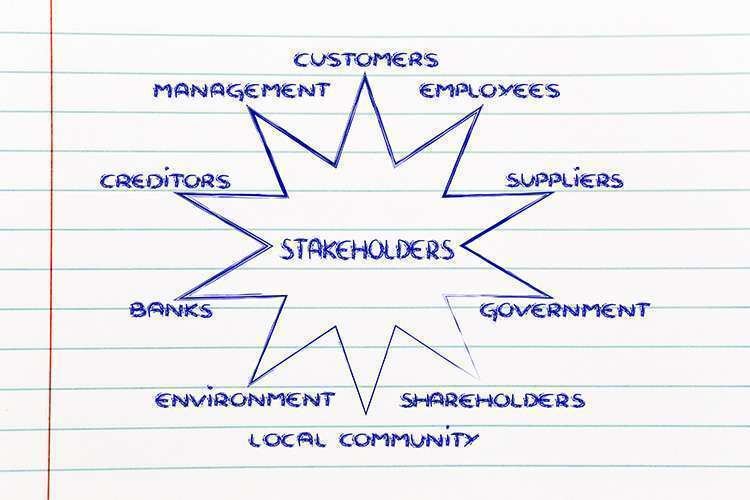-
Finding Ways to Improve Stakeholder Engagement in the Procure-to-Pay Process
17Procurement professionals work with a wide range of people throughout the company as well as suppliers outside the company. These internal and external stakeholders play a vital role in procurement. Engaging internal stakeholders and effectively managing external stakeholders can make a huge difference in how well a procurement department performs.
Though often traditionally siloed, procurement can play a collaborative and strategic role in companies. When procurement departments engage stakeholders, they’ll have a much easier time understanding procurement’s role in the company, hitting cost-saving goals, and supporting company-wide strategy.

Who Are the Stakeholders?
Whether you’re thinking about stakeholder engagement for the first time or evaluating an existing stakeholder engagement process, you’ll want to start by identifying the stakeholders.
Internal stakeholders include everyone at the company with involvement in the procurement process. That includes employees making purchases using the system, purchasing managers, department and budget owners, and accounts payable employees. It also includes those in the periphery of the process, such as finance, legal, and IT teams who could influence the procurement process but aren’t necessarily directly using the system. Plus, senior management has a stake in procurement since it’s a key part of company finance.
External stakeholders include vendors, suppliers, and any other outside parties with a stake in the procurement process. Interacting with these stakeholders comes under the umbrella of supplier management.
Why Worry About Stakeholders in Procurement?
One of the things the Deloitte Global 2021 Chief Procurement Officer Survey reported on was the focus of top-performing chief procurement officers (CPOs). Top-performing, agile CPOs and their procurement departments “Focus on relationships and influence across functions and supply markets.” For these successful procurement officers, “stakeholder/customer management [is] at the center of their strategy.” They have a collaborative, holistic approach.
Let’s look at one example. Maverick spending is a perennial problem for procurement departments. It happens when someone making a purchase for the company goes outside the approved procurement process. Engaging stakeholders who make purchases in the procurement process can help decrease maverick spending and increase the percentage of spend under management.
Do Stakeholders Understand Their Roles?
Even if the procurement department understands who their stakeholders are and what role they play, that doesn’t always mean the stakeholders share their understanding. As your procurement department works to understand stakeholder roles and increase stakeholder engagement, make sure you’re looping those stakeholders in on the process.
As key players in the procure-to-pay process, it’s the procurement department’s responsibility to make sure stakeholders understand their relationship with procurement. For example, they’re responsible for communicating procurement policies to employees making purchases, for working with department/budget owners to ensure that purchases stay within budget, and for keeping IT in the loop if procurement wants to update software systems.
Procurement is also responsible for ensuring that the procurement process aligns with larger company policies. For example, procurement must comply with certain legal requirements and may work with the legal team in the company. They’re also responsible for data collection and reporting related to the procurement process.

How Do You Encourage Stakeholder Engagement?
If procurement focuses only on cost-savings and budgets, and communicates that to stakeholders, you’ll end up with transactional relationships with stakeholders. They’ll see procurement only as a place to do specific tasks and then forget about. Procurement can shift this attitude by doing their homework to understand stakeholders, asking questions to clarify stakeholders’ wants and needs, and sharing the value of what procurement does. Time spent building relationships will pay off in the long run.
On a broader scale, the procurement department needs to understand the overall goals and priorities of the company. The better you understand the business, the more value you’ll be able to deliver to stakeholders and the more engaged they’re likely to be in the procurement process.
Two strategies for increasing supplier engagement include embedded teams and surveys. Both of these methods are mentioned in the previously cited Deloitte survey. Some of the survey respondents embedded procurement team members in cross-functional teams. Others recommended internal “customer satisfaction surveys” to measure how stakeholders view the procurement process.
What About Supplier Management?
We’re mostly focusing on internal stakeholder engagement in this post, but let’s not forget the importance of external stakeholders. The procurement department will function much better if suppliers and any other external stakeholders are also engaged in the procurement process.
Finding and implementing effective supplier management strategies is an ongoing challenge for procurement departments. Effectively communicating with suppliers, clearly communicating your company’s policies and needs, understanding the suppliers’ side of the equation, and paying invoices on time all contribute to good relationships with suppliers.
Supplier management is much easier with business process automation (BPA) software. The system makes it easy to collect all the supplier information in one place. You can handle all aspects of supplier management directly in the software, including communication with the suppliers. With NextProcess, you can also set up a supplier self-service portal so your suppliers can receive limited access to the procurement system. That allows suppliers to submit missing or corrected documents, update their own information, and check the status of invoices.
What Role Can Process Automation Software Play?
As you’ll know if you regularly read this blog or keep up with procurement news, cloud-based BPA software is a popular tool for effectively managing the procurement process. One of the key benefits that a BPA system can offer is a centralized software platform for managing every aspect of procurement in one place.
A centralized procurement system is vital for stakeholder engagement because it enables streamlined communication and involvement. With a central, cloud-based system, stakeholders can log into the procurement system from anywhere with internet access. The system streamlines the process and provides more direct involvement for stakeholders. You’ll notice even better results if you automate the entire procure-to-pay process with an end-to-end software solution like NextProcess. We also don’t charge additional fees for adding users, so you can give every stakeholder access to the software at no additional cost.
With NextProcess, you can customize the software as needed for your company. That includes customizing the access that different users have to the software. Stakeholders can interact with the software differently based on their roles, all while everyone has access to the same system and data. If you’d like to learn more or set up a free demo, contact us today.